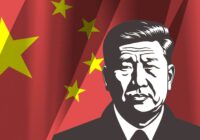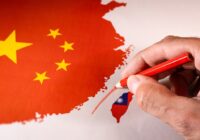For peace to prevail, China must show restraint with its territorial disputes in the Asia Pacific.
In April, Chinese President Xi Jinping announced a new security doctrine proposing an international system for security governance based on Asian features, which included openness and inclusiveness. The Chinese leader emphasized that the US pivot to Asia has not brought peace to the region. “Hence, the U.S.-led alliance system is not the right option to safeguard the peace and stability of Asia.”
From the Chinese president’s comments, it seems this new strategy is mainly to counter US efforts to rebalance power and address rising security tensions in the Asia Pacific.
President Xi also called for the region’s countries to work together with China to safeguard peace and stability. The policy envisions a regional security model with a “dual-track approach,” integrating the Chinese dream of national rejuvenation with the Asian dream for a brighter future.
The United States, however, has continued its involvement in the Asia Pacific, and on May 10, Washington sent a warship to the South China Sea. The matter further escalated when two Chinese military aircraft intercepted a US military reconnaissance plane on May 17.
The Standoff
China has territorial disputes with multiple countries that surround it, including Japan, Brunei, Malaysia, the Philippines, Taiwan and Vietnam. The issues are mainly related to claims over three clusters of tiny islands—one in the East China Sea and two others, Paracel and Spratly, in the South China Sea.
The dispute in the East China Sea is with Japan over an uninhabited 7-kilometer-wide island known as Senkaku by the Japanese and Diaoyu by the Chinese. This island has been controlled by Japan since 1895. The Paracel islands have been held by China but claimed by both Taiwan and Vietnam as their own. A cluster of 100 small islands called Spratly is part of a larger contention, with the Philippines, Malaysia, Vietnam, Brunei and China all staking their claims.
Control of the uninhabited islands is important for four reasons. First, about $5 trillion in sea trade passes through the region. Second, the Asia Pacific is rich in natural resources. Third, it offers rich fishing waters. Fourth, the key reason behind the territorial dispute surrounds geopolitics, especially due to the dominating nature of China. Beijing’s presence in the area raises not only sovereignty issues, but also security concerns to these nations.
By the end of May, an international arbitration ruling was expected on a case filed by the Philippines, disputing China’s claim on the entire South China Sea. Beijing has not only rejected the procedure, but also rushed into expanding its territorial claim by building islands, including an area falling in the Philippine economic zone and within 200 miles of that country.
Since the case was first filed in 2013, China has built seven islets in sea water to its south by piling sand on reefs. In 2015, Beijing also built an airstrip on one such island, the Fiery Cross Reef. Similar industrial construction projects have been reported in at least two other islands in the Spratly Islands.
Rising Tension in the region
These activities have become a point of international contention, resulting in rising tension that is clearly seen from the increased military budgets of countries in the region. According to the Stockholm International Peace Research Institute, military spending has risen by 167% in China, 30% in the Philippines and 170% in Vietnam. To put pressure on China, the US sent a Navy destroyer to the area in late 2015 and again in January 2016 before the latest episode in May.
Sino-Japanese tensions have escalated since 2013 when China announced the creation of an air-defense identification zone covering Senkaku island, requiring all aircraft flying over the zone to comply with rules laid down by Beijing, which was seen as “unilateral escalation” by Japan and the US.
Diplomatic Efforts and Counter Efforts
To provide support to countries in the region, US President Barack Obama sought to cement closer ties between Washington and the Association of South East Asian Nations (ASEAN) by hosting a summit in February. During the conference, a joint statement was issued emphasizing the need for respecting sovereignty and international law in the Asia Pacific. While it was good for symbolic support, it fell short on expectations of nations having territorial disputes with China, especially since the statement did not specifically name that country.
Considering the hostility in the region and the US intervention in it, China has launched aggressive diplomatic efforts aimed at influencing other countries to limit “outsider” influence and resolve territorial issues in the South China Sea.
During his recent visits to Cambodia, Laos and Brunei, Chinese Foreign Minister Wang Yi tried to alleviate fears over Beijing’s regional dominance, and he declared that the island issues should not impact their relations. In April, President Xi went further with an offer to have “a frank talk about the South China Sea issue.”
Long-Term Impact
Developments in the South China Sea have implications beyond the region. Some analysts believe that China is building military bases across the Indian Ocean as part of a “String of Pearls.” After the completion of such bases, there would be further international danger if China moves its dredgers and equipment to other places in the region. For instance, China may build and use islands to form a logistics chain in the Indian Ocean Rim (IOR).
India has been looked upon by smaller countries in the region for support, similar to what the US gives in the Asia Pacific. Even the US expects India to play an important role for balancing China. IOR countries have hosted talks at summits for regional security and economic development. Significantly, India, the US and Japan hold an annual joint naval exercise called Exercise Malabar, while in 2015, an Indian warship visited Vietnam for operational preparedness.
Responsibility for Peace
With China as an emerging superpower, Filipino President Benigno Acquino has a valid question: “To be realistic about it, how does one push around a superpower?”
Over the past 100 years, we have seen two devastating world wars resulting in large-scale destruction and loss of life. Meanwhile, two competing superpowers, the US and the Soviet Union, had decades of diplomatic tension and waged a Cold War. However, both countries succeeded in proving to be a counterbalance for the other.
After the Soviet collapse, the US unilaterally took over the responsibility of being the global peace administrator. Fortunately, the world has managed to avoid a major international war by containing conflicts to smaller regions and avoiding direct violence between two superpowers.
But while Russia has suffered an erosion of its superpower status, China is fast emerging as a new superpower. The current military escalations in the Asia Pacific have not triggered any serious war, however, we must learn from history that expansionist agendas of superpowers often lead to destruction.
Hopefully, as announced President Xi, China is genuinely interested in a peaceful resolution of disputes by direct and pressure-free talks between regional countries. It is important for the aspiring superpower to show more restraint for the benefit of world peace.
The views expressed in this article are the author’s own and do not necessarily reflect Fair Observer’s editorial policy.
Photo Credit: Kremlin
 We bring you perspectives from around the world. Help us to inform and educate. Your donation is tax-deductible. Join over 400 people to become a donor or you could choose to be a sponsor.
We bring you perspectives from around the world. Help us to inform and educate. Your donation is tax-deductible. Join over 400 people to become a donor or you could choose to be a sponsor.
Support Fair Observer
We rely on your support for our independence, diversity and quality.
For more than 10 years, Fair Observer has been free, fair and independent. No billionaire owns us, no advertisers control us. We are a reader-supported nonprofit. Unlike many other publications, we keep our content free for readers regardless of where they live or whether they can afford to pay. We have no paywalls and no ads.
In the post-truth era of fake news, echo chambers and filter bubbles, we publish a plurality of perspectives from around the world. Anyone can publish with us, but everyone goes through a rigorous editorial process. So, you get fact-checked, well-reasoned content instead of noise.
We publish 2,500+ voices from 90+ countries. We also conduct education and training programs
on subjects ranging from digital media and journalism to writing and critical thinking. This
doesn’t come cheap. Servers, editors, trainers and web developers cost
money.
Please consider supporting us on a regular basis as a recurring donor or a
sustaining member.
Will you support FO’s journalism?
We rely on your support for our independence, diversity and quality.






